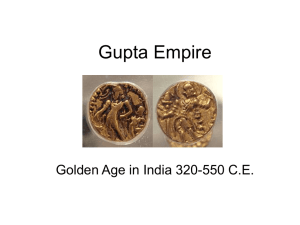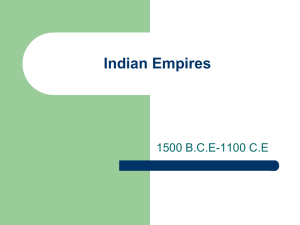Agenda for research in dry regions
advertisement
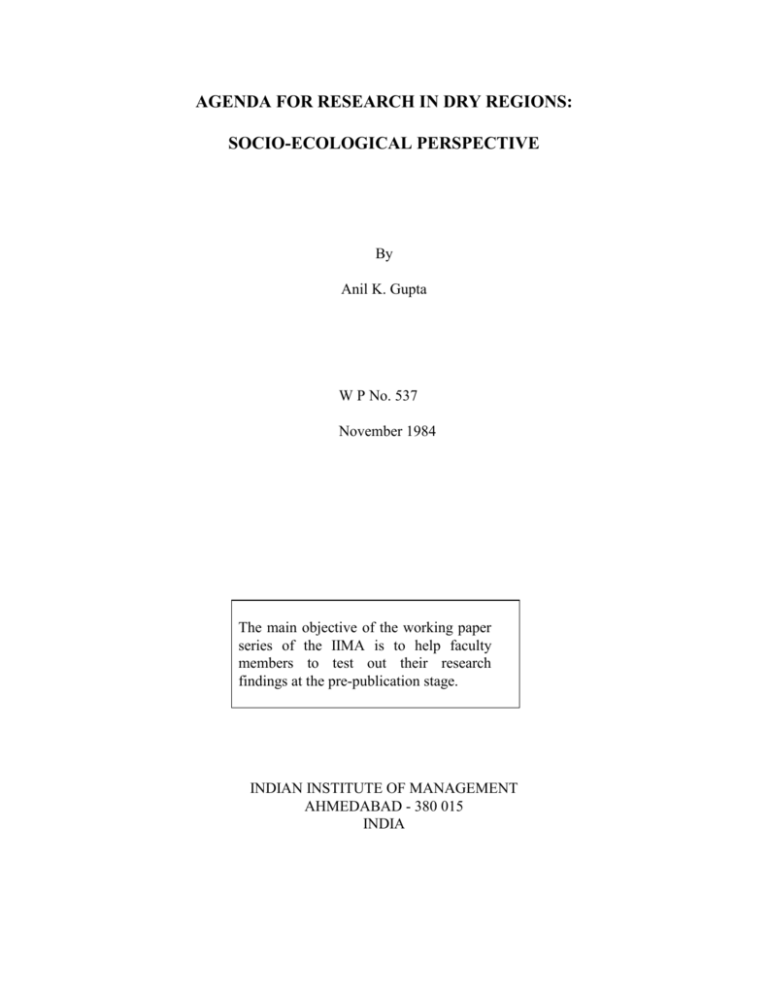
AGENDA FOR RESEARCH IN DRY REGIONS: SOCIO-ECOLOGICAL PERSPECTIVE By Anil K. Gupta W P No. 537 November 1984 The main objective of the working paper series of the IIMA is to help faculty members to test out their research findings at the pre-publication stage. INDIAN INSTITUTE OF MANAGEMENT AHMEDABAD - 380 015 INDIA Paper presented for CMA Workshop November 9, 19, 1984 AGENDA FOR RESEARCH IN DRY REGIONS: SOCIOECOLOGICAL PERSPECTIVE ANIL K GUPTA Centre for Management in Agriculture Indian Institute of Management Ahmedabad AGENDA FOR RESEARCH IN DRY REGIONS: SOCIO-ECOLOGICAL PERSPECTIVE* There has been expressed, in recent past, lot of concern towards the problem of improving level of living of majority of small producers in regions with poorer ecological endowment and higher environmental risks. Existence of low population density, generally dispersed settlements, very high degree of heterogeneity in natural resources endowment (soil fertility and topography, rainfall pattern within small localities, intensity of various factors causing ecological imbalance etc.) together with historical accumulation of deficits in the household budgets of most of the poorer people required a very different analytical approach for studying the problems of dry regions than the one generally adopted. Research framework suitable for uniformly endowed irrigated regions would obviously prove totally inadequate for dry regions (Krishnaswamy and Patel 1973, Vyas et.al 1976, Gupta 1981). Yet, the macro developmental policies as well as design of delivery system (including the decentralised agencies like DRDA) hardly demonstrated any specific adaptation to the complexity of dry regions. The problem was compounded when research resource allocation for dry regions also remained highly restricted due to both supply and demand factors (Jodha 1983, Gupta 1981). The continued neglect of dry region problem has already been manifested in several respect such as high rural-urban migration from these regions; stagnancy in production of pulses besides some oilseeds and millets: severe constrain of draught power which further restricted adoption of many of the new time-bound technological packages; recent spurt in violence around grazing lands and inequitous access to private fallows as well as village commons; increasing regional imbalances and of course massive expenditure on relief necessitated due to frequent droughts or in some parts even occasional snap floods. The technological, administrative and organizational, socioeconomic and cultural aspects of dry region problems required an inter-disciplinary approach which socio-ecological perspective recently developed at the CMA helped in pursuing comprehensively. We have reviewed some of the important studies done by CMA in last decade in this regard separately. The important implications flowing from these studies have been very briefly drawn upon in the list of issues mentioned below. Since it is a preliminary draft no attempt has been made to list the problems in the order of priority. It is also possible that some of the relevant concerns might have been ignored or under played due to author’s biases or just inadvertently. It is expected that discussion on this note will * This notes includes, general researchable issues based on my own work as well as by other in CMA and outside. Detailed assessment of my own work (1981-84) is presented in the note entitled, “Future Research concerns in Dry Farming Regions: a Self-critical review” 1984 and review of CMA studies other than mine on Dry farming during 1973-1983 are included in the note, “Analytical Review of Selected CMA studies in dry Regions: 1973-1984”. 1 generate both, a priority for CMA’s concerns in this regard and also a perspective for focussing attention of other fellow researchers interested in the subject. It may be added that historical bias in national research policy towards irrigated regions has generated a peculiar dilemma for social science research. Most of the senior researchers with very few exceptions, even when began with the enquiries in dry regions, got lured into the extremely attractive research opportunities available in better endowed regions. Thus when national attention started being focussed on dry region problem in recent past, it is learned that not many institution and individuals appeared interested or available for pursuing these problems. Those who indeed showed interest tended many times to apply perspectives and skills developed in dealing with problems of irrigated regions. Further the internationally sponsored research also has contributed in some ways, towards complicating the above scenario.1 Therefore when we look at the management2 concerns in dry farming research we may find above backdrop probably useful. It has implications for not only generating right questions but also ensuring that there were people identified who would pursue these with the right perspective and persuasion. Networking amongst the already involved scientists would become a logical concomitant of this need and CMA is in an unique position to perform this role. Conceptual framework Several CMA studies in past, notably the ones pursued by Profs. Krishnaswamy, Srivastava, Vyas and rural development group including Profs. Ranjit Gupta, BM Desai, TK Moulik, etc. have pointed out the need for conceptualising the problems of dry regions differently from the other better endowed regions. Recently a socio-ecological perspective3 on household economy in semi-arid regions has been developed synthesizing lot of earlier work by this author as well as others. In figure one given in Appendix-one, the key elements of this framework are listed. Essentially it implies that mix of economic enterprises (crop, livestock, craft, labour etc.) in any given region was defined by the ecological conditions in a historical 1 Dr. Jodha (1983) in a recent paper underscored few more dimension of this problem such as: professional unattractiveness due to inability of dry regions to ensure, “use of standardized methods, stability of results and possibility of quick and assured rewards through experimentation under usually high input conditions”. He also refers to the use of dry farming research stations as centres of punishment posting just the way it was done in bureaucracy. Profit. Vyas (1976) mentioned how people on punishment, probation or promotion were posted to these regions with often very transient interest/stakes in solution of long and short term problems. 2 Management is a science of anticipation. It is used here in a wider context in which conceptual problems of generating relevant futuristic research issues and pragmatic approach of concurrent problem solving are very delicately balanced. The focus is on organizaton, institutions and systems (public or private) which intervene indirectly through markets or directly through programmes/ projects affecting farmer level decision making. 3 Detailed discussion on this perspective is provided in the study by Anil K. Gupta on “Small Farmer Household Economy in Semi-arid Regions, 1984, forthcoming. 2 context. The scale at which different classes of producers operated these enterprises depended upon the historical reserve of surpluses or deficits, access to credit, labour and product market (which are crucially interrelated), risk bearing capacity etc. The technological choices in various sectors, spaces and of different classes could be appraised in the given Mean variance matrix which was socio-ecologically defined. This generated in a cumulative manner different perception of risk inherent in dry region economy at the level of various households. The diversification of enterprises, technological level, access to institutions, perception of risk vis-a-vis actual risk, access to public, communal risk adjustment devices etc. generated stable or unstable cashflows. These in turn led to accrual of surpluses at some holdings and deficits at another. The stakes in environmental protection were a critical function of whether a household has a surplus, subsistence or deficit budget. This ultimately in a dynamic way modified the mix of enterprises. Thus the typical livestock and crop specie mix found at the level of different classes of farmers together with dependence upon migration (seasonal or permanent), non-farm craft activities etc. reported by various researchers could be analysed in above framework. Some of the structural features of dry region ecology like less population density, dispersed settlement system, high degree of labour mobility etc. were mentioned in the beginning. Some other associated features could be added such as, fragmentation of holdings, higher incidence of salinity and alkalinity hazards, predominant role of livestock (generally bigger farmers specializing in grazers with poorer farmers and labourers in browsers), very poor administrative and institutional infrastructure, considerable reliance on relief through externally injected resources (see Jodha 1983, Vyas and Khanna, 1982) and high level of income disparities accentuated through exploitative role of big farmer-trader-lender in particularly years of crop failure or livestock epidemics. We may suggest two cautions at this stage: One) We should guard against the possibility of falling into the trap of `ecological determinism’. Two) Following from above, policy framework (whether for prices, rates of interest, insurance, subsidies, institutional design etc.) for dry regions could not be explored in isolation of the framework for other regions. The implications of above would become clearer when we discuss the research options given below: Research Options: Institutional/Organizational 3 1. Design or Delivery System4 a) Can sedentary organizations designed to serve sedentary populations serve mobile population? How to organize delivery systems which did not pass on the problem of gaining access on to the poor who should either organize, protect or demand the services which these organizations are infact set upto to supply? The cost of delivery in low population-density regions was inherently high. Similar financial and budgetary allocations here per capita or per unit of area would intensify regional imbalances. How to design fiscal policies which avoided such an outcome? b) c) Many times while replicating programmes across different ecological regions, the uniform administrative set up was followed for instance, in T & V System. If a VLW was expected to cover same number of households or village in high and low population. density villages, it was inevitable that services should suffer in the backward region. How to design bureaucratic structures for various programmes including DRDA which took different structural constraints into account? d) In risky regions, the delivery system was expected to perform more efficiency because, one) the markets were very weak, two) the uncertain rainfall necessitated a high degree of preparedness and resourcefulness on the part of the farmer. How to design monitoring and control system which ensured that reverse was not the case. There were several other issues like, existence of large number of vacancies, absence of any incentives for postings in such areas, lack of basic amenities, predominance of female headed households (when male migrated away seasonally and bureaucracy proved singularly ineffective in dealing with women clientele), uniform population and costing norms in terms of per capita or number of people per unit of facility (e.g. a bank branch was expected to serve 17000 people all over the country regardless of population density), similarly budgetary system despite known as predictable instances of delay, uniform location norms (guided often by growth centre theory which had proved highly inadequate for developing economies) etc. As the review of CMA studies shows large number of institutional inadequacies have been noted in revenue (or so called regulatory wing) administration having implications for development. While employment oriented programme as well as drought relief works continued to remain with revenue administration, the myth of developmental and regulatory dichotomies in administration continued to influence training and research efforts in development. There is urgent need to look into systematically the links which already exist and also the ones which need to be forged between various wings of administration and organization in dry regions. Highly diversified households in such region necessitated highly diversified programme delivery. 4 Also see, Anil Gupta, 1984 Role of Public enterprises in backward region, IIMA,W.P. No.511. 4 B. Technology a) There is a need to document the traditional selection criteria for varietal selection in crops as well as livestock so as to integrate these organically with the breeding objectives for future. e.g. in a labour surplus economy, synchronous varieties severally constrain the option of subsistence households to manage sowing or harvest within a limited period of time. b) There is a need for social science contribution at the Ex-Ante stage of setting up technological priorities. The scope of such interaction will depend upon the ability of management scientists to demonstrate the feasibility of such contribution of identifying precise characteristics of the niches for new technologies as well as the constraints at various levels of farmers to be resolved by these technologies. c) As against `package' approach, recent attempts amongst dry farming scientists to develop `tiers of technology' deserve better and urgent attention of management scientist so as to improve technological diffusion process. d) Risk has been known to be an important factor inhibiting experimentation with high mean-high variance technology. Instead of/or together with direct relief, there is a need to launch action-research projects on credit- linked insurance* so as to trigger technological transition in a big way. The real trade off is between sustained expenditure of huge amount in adhoc manner and massive investments now so as to reduce future needs for relief. e) In case of livestock, the draft power constraint is becoming extremely severe. In some region number of bullocks has gone down in absolute terms in last two decades. This has direct implication for timely sowing, land preparation, interculture, bullock or camel drawn implements etc. Likewise livestock breeding policies for dry region also need to be looked into. Another problem which is likely to assume serious proportions in near future is the problem of violence around grazing lands. The extraordinary spurt in dry fodder prices during 1979-80 drought caused lot of distress amongst poor leading to disposal of livestock in large number of cases. Policy for divising a public storage and distribution system for fodder in dry region needs an urgent attention. C) Cottage Industries In case of cottage industries which have flourished historically most importantly in dry region, there were large number of issues which needed attention. Some of the problems were, a) the value addition locally as against the outside (e.g. wool, leather, sisal etc.) b) skill and technological upgradation besides of course marketing and credit support to * Also see, Anil K.Gupta 1983, Credit Arrangement for drought Prone region: Policy prescription and Planners reactions, IIM-WP 478. 5 artisans c) there were certain crafts which were adversely affected by public policies of revenue extraction (e.g. recent decision to auction palm trees for toddy extraction rights in a particular state affected those who made brooms with its leaves), lot of employment potential existed in other cases like sisal processing but viable organizational alternatives remained to be developed, the export corporations for these goods often procured the goods through intermediaries in the absence of effective KVIC system, import policy (for instance for woolen rage, yarn etc.) affected the prices of products of artisans many times adversely, etc. There was a need to study the organic link that existed between crop-craft-labour and livestock as mentioned earlier so that mutually reinforcing policy set emerged for dry regions. D) IRDP in dry regions There was an urgent need to explore alternative model of IRDP for dry regions which could effectively deal with many of the points made already. The weak marketing structure of the produce of poor was an important lacunas as was the problem of supply of raw material (e.g. even in a tribal district, the bamboo had to be bought from outside for basket making whereas local bamboo was marketed/contracted out). The norms regarding subsidy, procurement, insurance (insurance companies did not reported renew the policy in case of sheep and goat)5, provision of second loan, failed enterprise subsidy (knowing the large scale failure was quite likely in such regions) follow up and rehabilitation etc. needed careful attention. Even the structure of DRDA and the population coverage norms as proposed in the background papers for VIIth Five year plan needed reconsideration. E) Credit Policy Large number of studies have been done at CMA and elsewhere on the problem of credit. There are several schools of thought ranging from the one which calls for higher rate of interest and major role to informal lenders (Desai 1976) to those who argues for a totally different approach to credit for any regions (Gupta 1983) emphasizing subsidy for making organization viable and at the same time promoting portfolio approach to credit disbursement for multi-enterprise poor households. Key issues needing attention are: a) How to organize delivery system for disbursing large number of small loans needed frequently and repayable in cash, labour or kind ?* 5 See the study on ecological adaptation of credit delivery system in Jhabua by Prof. Anil K. Gupta and Prof. Manu Shroff, 1984, forthcoming (part of ongoing rural development Action-Research Project of CMA-PSG coordinated by Prof. Ranjit Gupta on Creation of demand groups) * Anil K. Gupta 1983 Impoverishment in Drought Prone regions, SDC/NABARD/ IIMA RBI mimco. Also see a case written on the subject by Prof. BM Desai (1976) - based on Dharampur Project. 6 b) How to devise viable policy for developing different repayment schedules in different ecological regions and for various classes of farmers for the same enterprise due to different level of consumption deficits. c) How to ensure the branch expansion policy of banks particularly RRB is not biased against dry region? How to develop different viability norms for RRB and its branches in dry regions? How to devise control policies for subsidising cost of RRB operations in dry regions? d) There is a need to devise monitoring systems which ensure a match between Bank portfolio and enterprise mix of poor in different regions? Today eventhough District Credit Plans were prepared block and purposewise, they were monitored sectorwise and that too at district level. e) How to improve the coordination system between banks and district administration? To whatever extent the banks still remain the only autonomous organizations at district level, the problem of authority vis-a-vis influence of collector remained an endemic problem in most of the districts despite posting of RBI lead officers. f) The credit allocation for certain enterprises in which majority of poor were engaged like sheep, craft, etc. was even less than fraction of a percent in many of the drought prone districts. g) Innovative systems for credit delivery to nomadic or semi nomadic populations also needed to be developed. h) The problems of overdues had assumed serious proportions. However no particular relationship was observed between probability and extent of crop failure in a particular mixed region with overdues in a recent study. The regions with least risk infact had more overdues at district taluka and village level (in talukas of a particular district) in Gujarat. Also the financing done during 1969-71 in the early phase of nationalization (when banks lacked enough experience) needed a very different treatment from the rest. Likewise scarcity-induced-genuine overdues deserved to be dealt with differently from the other more deliberate type of overdues. There hardly existed any policy for rephasing and rehabilitation of loans without Gazette notification in commercial banks. In fact despite the fact that formal credit intervention began with Deccan riots triggered by extraordinary spurt in informal rates of interest and exploitation by money lenders after drought, no specific policy bias for credit in dry regions has still now been created in the country. At the same time policies for making loan costlier for bigger and irrigated farmers also needed to be vigorously pursued and explored. F) Restoration of Ecological Balance 7 Even though one of the major objective for DPAP was restoration of ecological balance, the progress in this regard has been extremely tardy. Recent studies have shown the importance of silvipastoral system (Prof. Tirath Gupta 1983) and also provided evidence that poor were better conservator of resources (Gupta 1984). There was a need to systematically review the existing policies of central and states in this regard to build proper framework for landuse in dry regions. Problem of shorter time frame in which poor had to manage survival and longer time frame in which rich managed surplus extraction posed the key dillema in dry regions. The fragile social balance amongst losers and gainers (the beneficiaries of public investment in irrigation and electrification) in dry regions hinges to a great extent on the way public interventions will be made or not in future. Management discipline has a vital role to play by contributing towards the design of organization, institutions and access modes enabling poor to influence and ultimately control the resource flow. Role of State becomes singularly important in dry region which often fail to attract market forces. 8
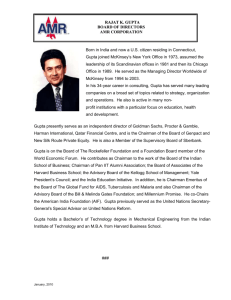
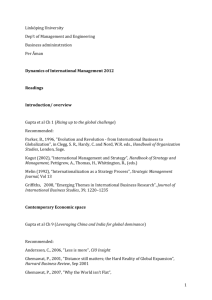
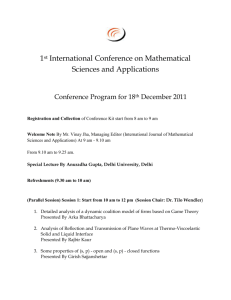


![How to prepare for the industry of the f[...]](http://s3.studylib.net/store/data/006625801_1-28d993b77928eebf9db4213fbb4f2207-300x300.png)
